Coming full circle in the North Cascades
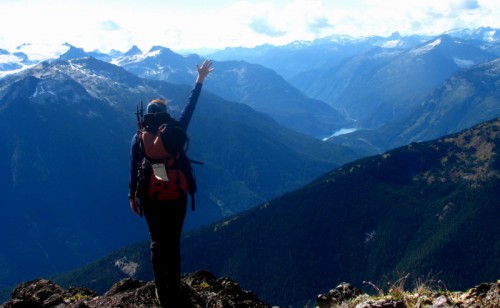
This is a time of transition.
The warm summer season is changing as rapidly into a drenching autumn as is my progression from the residency with North Cascades Institute to the academia of Western Washington University. As the leaves of vine maples alter their hues from green to orange, I find myself pulled from the slow-paced grandeur of North Cascades National Park to the fast-paced flurry of the city of Bellingham.
It seems as if during these transitions there is no definitive line that is crossed from one season to the other, no time to look back, only to move forward into the next, into another.
But even as the final two quarters of my graduate residency are about to commence and, in only a matter of six months, conclude themselves as well, I find myself already looking back, gazing out onto the memory-scape of this landscape, of this past year’s journey when I called the North Cascades my home. Here, I came full circle.
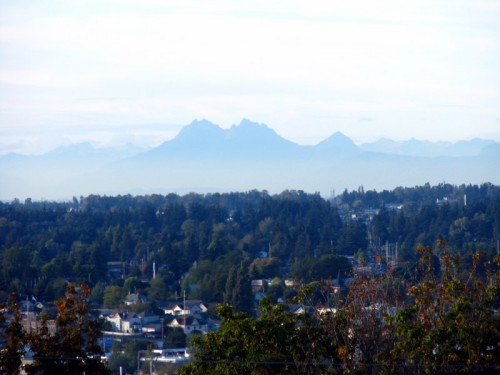 (Title) Waving goodbye to my North Cascades home (Above) Welcoming Bellingham
(Title) Waving goodbye to my North Cascades home (Above) Welcoming Bellingham
The North Cascades were never an unfamiliar place to me. The craggy ridge tops, the thick coats of glacial ice, the deep forested valleys of fir, hemlock and cedar incised by cascade upon cascade—all this and more were family. As if visiting a grandmother, my mother and father brought me here every summer to camp and hike, hunt and fish.
Names like Forbidden, Torment, Liberty Bell, Golden Horn, Silver Star and Shuksan were like often-visited cousins. Stories of rocks scaled and peaks summited were told around glowing campfires as if articulating our blood, our ancestry.
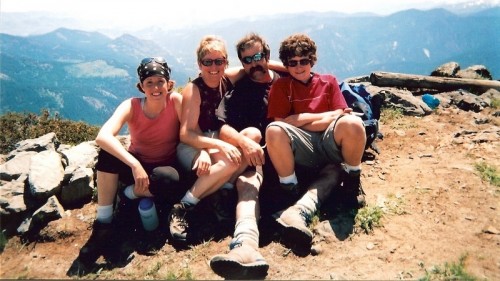 My family – me, Leslie, Derek & Garrett – atop Goat Peak in the Methow Valley
My family – me, Leslie, Derek & Garrett – atop Goat Peak in the Methow Valley
Growing older, my relationship with the North Cascades expanded to include not only a familial, but independent connection to this place. Within me, a desire to know more, do more, in these mountains was sparked.
In 2001, just emerging into high school, I canoed Ross Lake for the first time as part of North Cascades Institute’s Ross Canoe Camp. The following summer of 2002 introduced me to the South Cascade Glacier, partaking in the craggy ridges and glacial ice I had, at one time, only seen from afar, through another Institute youth program—Girls On Ice. In 2004, inspired by the extended family of the alpine zone, I took to an Introductory Mountaineering course through the Skagit Alpine Club as only a high school junior, allowing me to look upon the landscape as truly my home.
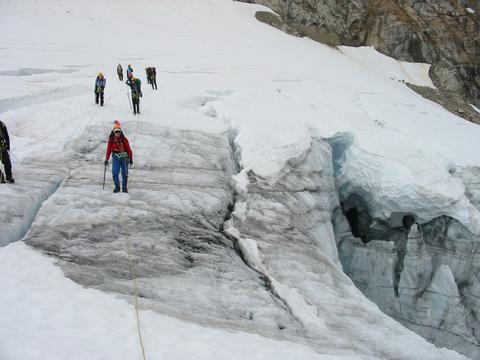 Me (in red) traversing the South Cascade Glacier for Girls On Ice 2002
Me (in red) traversing the South Cascade Glacier for Girls On Ice 2002
My Girls On Ice community at the top of the South Cascade Glacier in 2002
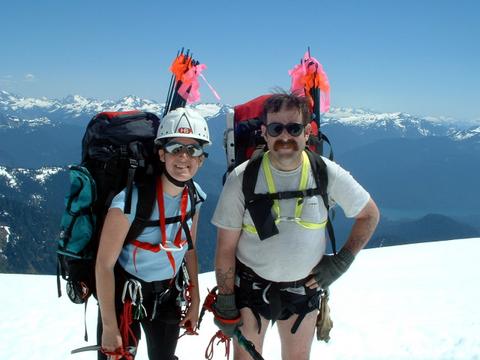 My Dad & I on Mt. Baker’s Boulder Glacier for the Intro to Mountaineering
My Dad & I on Mt. Baker’s Boulder Glacier for the Intro to Mountaineering
By the time I had reached the point of undergraduate graduation as an environmental educator, my connection to the North Cascades community was nearly complete. Yet, even after forging ties with the terrain for so many years, I felt there was a side to these mountains, this family of mine that still needed to be discovered, deciphered and experienced. It was a side that involved more than just mere ascents and traverses, vantage points and vistas.
The flow of nature was pulling me in the direction of further connection. I had known for years of the Masters of Education Residency offered through the Institute, it just all seemed surreal to me. The North Cascades as your backyard. Living and working year-round in the outdoors. Could this actually happen?
It can. And it did. For an entire year, August to August, then and until now, I lived slowly and learned quickly. There was never a moment I was not discovering further the other side of my majestic mountain family.
With 3rd through 12th graders, I walked like a wolverine, studied slugs, created glaciers and engaged all the senses through fall and spring Mountain School. Like flipping through a storybook, I wandered the Environmental Learning Center paths on my own, in every kind of weather, studying the progression of an entire year’s natural history, witnessing the smaller, more crucial moments of a snake smiling, a leaf falling, a raindrop wetting soil.
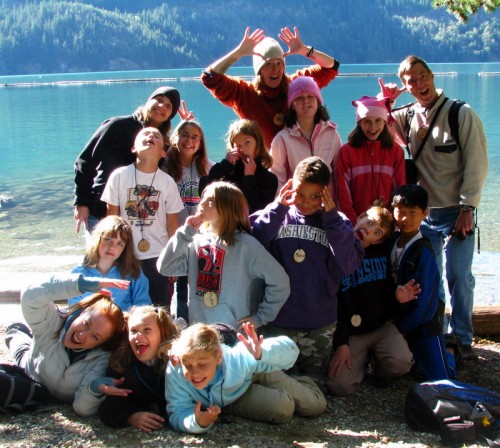 Enjoying a goofy Mountain School photo with students from Wade King Elementary
Enjoying a goofy Mountain School photo with students from Wade King Elementary
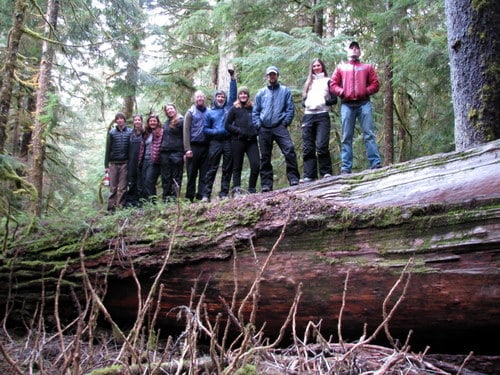 My cohort – C9 – exploring giant old growth trees in the Mt. Baker Wilderness
My cohort – C9 – exploring giant old growth trees in the Mt. Baker Wilderness
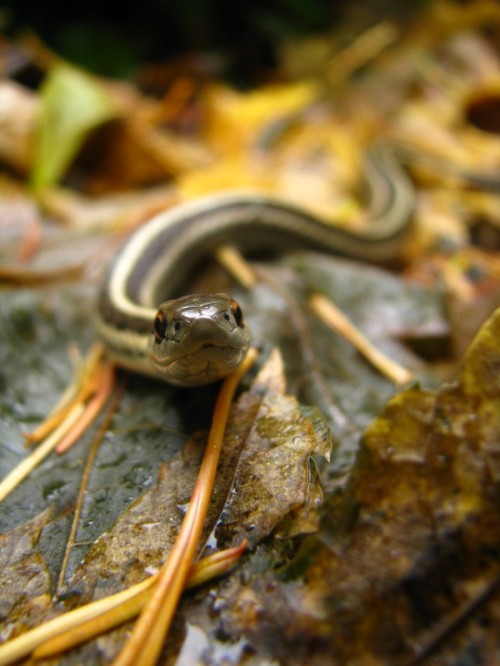 The small moments, like witnessing this snake smiling, were truly inspirational
The small moments, like witnessing this snake smiling, were truly inspirational
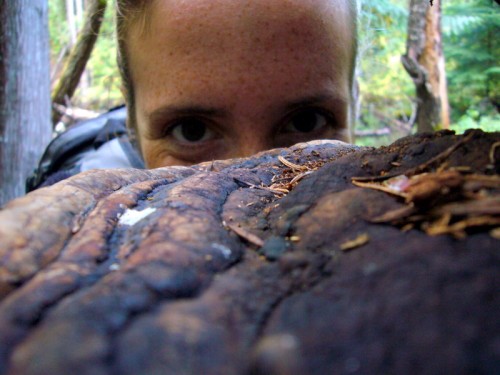 Wide-eyed and wondrous, gazing over a shelf fungus
Wide-eyed and wondrous, gazing over a shelf fungus
In the dead of winter, I watched the sun kiss Diablo Lake for a mere hour and a half, as it rose from the summit of Ruby Mountain and set behind Colonial Peak, the rest of the day cloaked in twilight. I ate wild blueberries and identified wildflowers. I listened patiently for songbirds and smelled the faint vanilla of ponderosa pine. Waltzing through ecotones of alder, birch, lodgepole and larch, I ascended many of my neighbors—Sourdough Mountain, Desolation Peak, Crater Mountain, Trappers Peak, Goat Mountain, Hidden Lake Peaks and Mt. Tomyhoi.
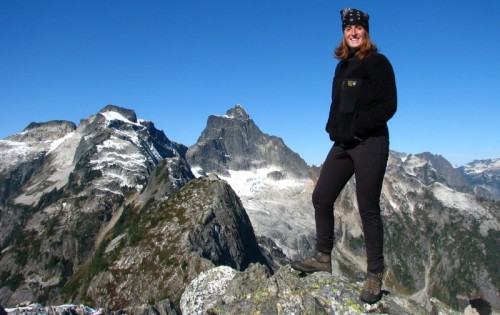 Mt. Triumph as viewed from Trappers Peak last October
Mt. Triumph as viewed from Trappers Peak last October
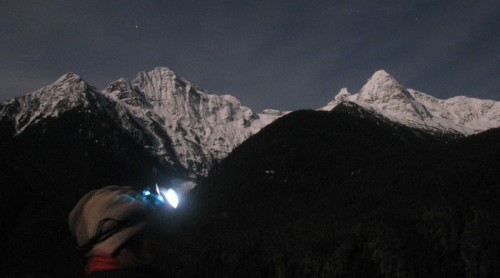 Watching Colonial Peak & Pyramid Peak at night, in the dead of a December winter
Watching Colonial Peak & Pyramid Peak at night, in the dead of a December winter
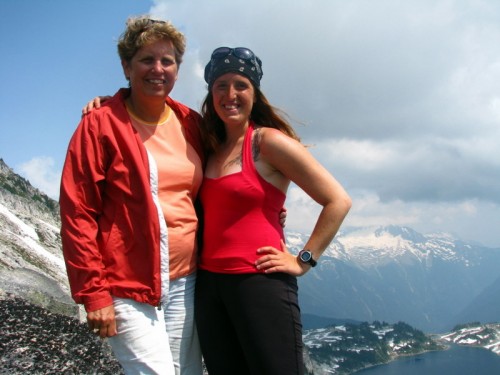 My mom Leslie and I at Hidden Lake Peaks Lookout in August
My mom Leslie and I at Hidden Lake Peaks Lookout in August
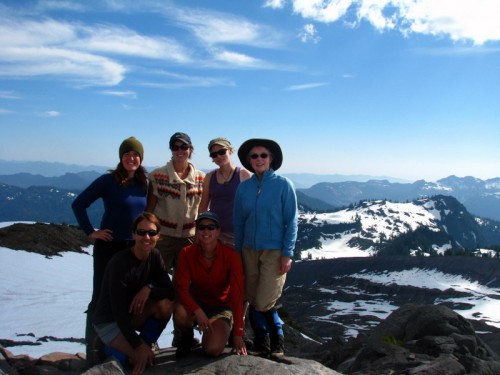 Me with other volunteers of Girls On Ice on the Easton Glacier this past July
Me with other volunteers of Girls On Ice on the Easton Glacier this past July
Understanding my mountain home inspired me to reaffirm myself in my own community on Whidbey Island, to give back to my home I am six generations a part of. In February, aboard the boat the Indigo, I taught marine science to seventh graders in Penn’s Cove with the organization, S.E.A. (Service Education Adventure)—seventh graders taking the same class I had taken so many years ago at Coupeville Middle School. In May, dressed as a 1860s era woman, I educated hundreds of visitors at the Ebey’s Prairie Ferry House with the Ebey’s Landing National Historical Reserve. This upcoming November, I will be exploring the beaches and bunkers of Fort Casey State Park with kids at the Ebey’s Forever Conference.
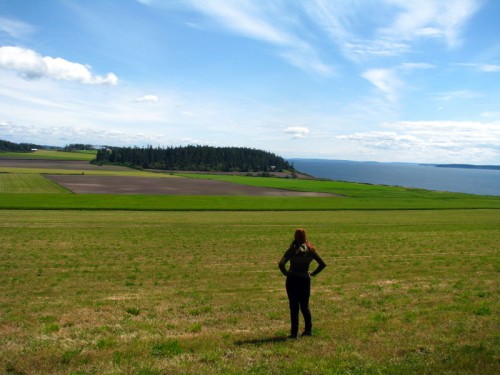 With new perspectives from my mountain home, I see my island home in a new light
With new perspectives from my mountain home, I see my island home in a new light
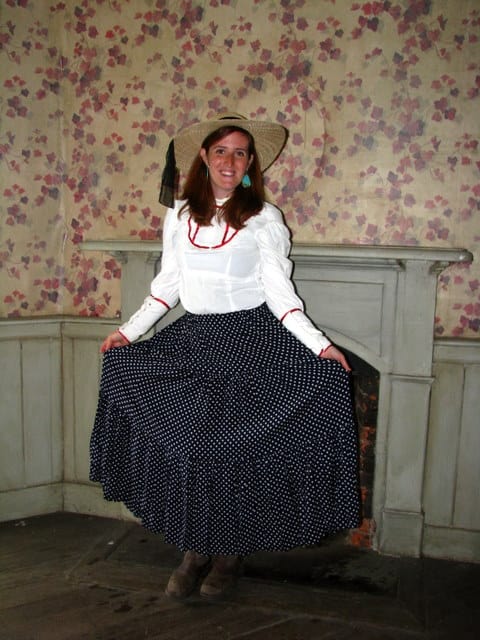 As an 1860s era woman, I talked to visitors at the opening of the Ferry House
As an 1860s era woman, I talked to visitors at the opening of the Ferry House
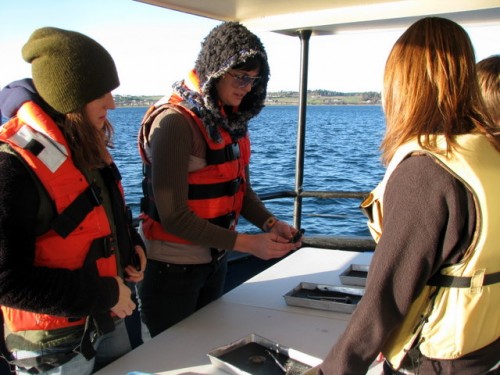 Teaching mussel anatomy alongside Megan Magee aboard the Indigo
Teaching mussel anatomy alongside Megan Magee aboard the Indigo
With each adventure this past year, a distinct memory was created, an impression made and a piece placed in the puzzle of my North Cascades family. But no experience was as inspirational as that of North Cascades Wild.
I recall the moment clearly. We—my co-instructors Kevin and Rebecca, and my students Janae, Jailyn, Karla, Rehmatullah, Jesus, Mercedes, Bal, Bhagi and Shan Hua—were sitting quietly around a fire at McMillan Camp. It was our final night. It was late. The stars were out. We had just spent the past 11 days canoeing Ross Lake, building a turnpike bridge, backpacking through thickets of thimbleberry, and discussing what it means to be a leader, and a steward, of this place. We were tired, stinking of nearly two weeks without showers, yet the happiest I had ever witnessed.
There, circling the glowing embers of the closing campfire, everyone had the opportunity to share about each other, appreciations. When it came my turn to be “appreciated†by everyone, I was nervous. This experience had been my first time instructing high school students for that long length of time in such an intimate, remote setting. What would they say?
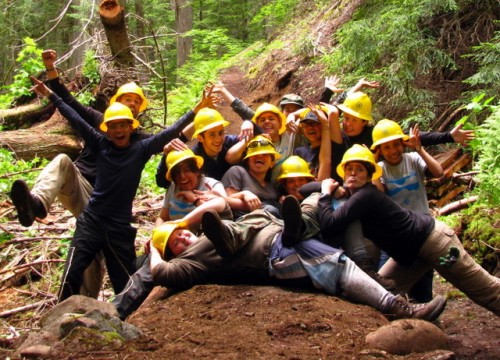 My first amazing North Cascades Wild community, Trip 2
My first amazing North Cascades Wild community, Trip 2
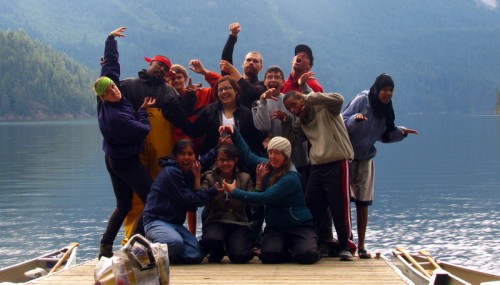 My other amazing North Cascades Wild community, Trip 5
My other amazing North Cascades Wild community, Trip 5
As the sharing went around, I began to smile. It was not just the comments that left me speechless; it was the confidence with which my students spoke, the way in which they carried themselves with honor and compassion as they talked about our community. Only 11 days earlier, we had all been strangers, in a strange place; people of different cultures, coming together in a place void of culture—wilderness—redefining culture.
The sharing circle finally came around to one my students, Janae. I had met Janae during the first spring day trip of the season in April, an opportunity we provide for Skagit and Whatcom students prior to the 12-day summer experience. She had been in my group, a prevailing presence. Now, four months later, around the cinders of our last campfire, Janae looked at me with genuine eyes and uttered the word Sister. It was at this moment that I had deciphered what the arduous ascents and grand vistas of my childhood could never solve.
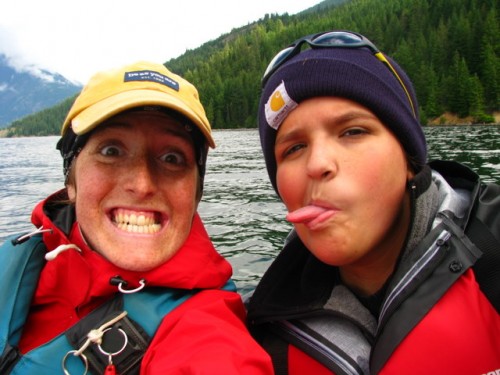 Janae and I canoeing on Ross Lake
Janae and I canoeing on Ross Lake
In the heart of the North Cascades, I found the heart of the North Cascades. I found my heart and rediscovered my family. The craggy ridge tops, the lush forests, the cascade upon cascade—their existence meant nothing unless they were shared. Seeing Janae’s and my other students’ eyes full of wonder and awe brought me back. Back to Girls On Ice, back to Ross Canoe Camp, back to those nostalgic summer vacations with Mom and Dad. From 2010, I was transported back to 2001, to 1991, from teacher back to student.
It all made sense now. The only way I could understand the other side of my North Cascades mountain family was to see it through the eyes of my students.
This a time of transition.
On this mountain pathway I have traveled from my youth to adulthood, I will take with me more than just memories and knowledge. Coming full circle in the North Cascades, I will take my family and my heart, and with them, the confidence to ascend the next peak with grace and grandeur, yet still the power to scream from a summit my everlasting presence in this place, my home.


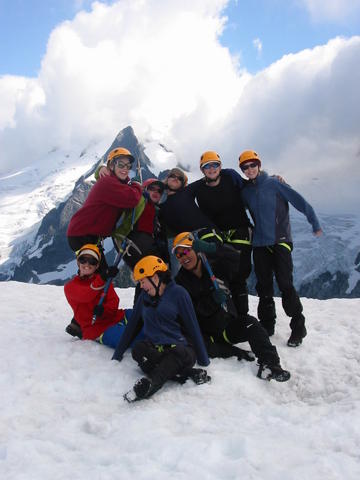
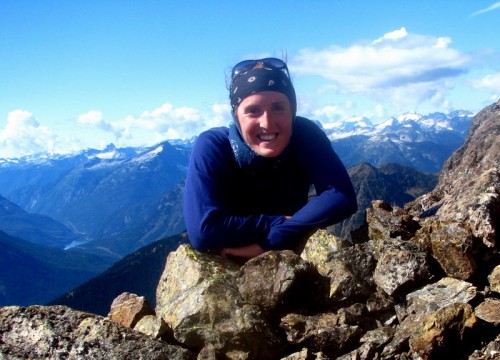
Your snake smiling picture is amazing! I love it, thank you for sharing 🙂
What a beautifully written history of yourself and your journey to adulthood. You have had some amazing adventures for one so young, and yet you realize that you have many more ahead of you in the years to come. I love how you liken the Cascades to your family, and incorporate one into the other. Well done!
This is superb Kelsi and we could not be more proud of you and what you are learning about yourself and sharing with others. Your writing shares your passion and sense of place for this beautiful piece of the Pacific Northwest-thanks for sharing it with the wider audience here. Love, Mom
Wow. Just wow. Thanks for sharing this personal journey with all of us. It is powerful to meditate on how a landscape can shape a person, and how a landscape can connect many generations. Lots to think on here. Thanks again!